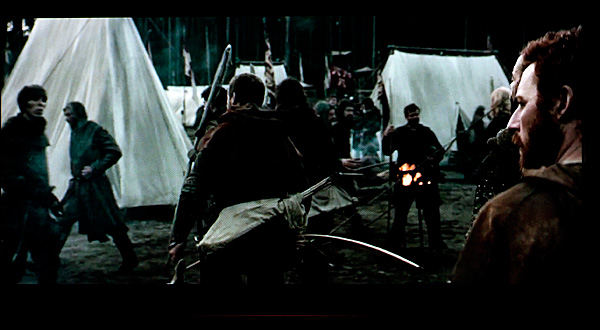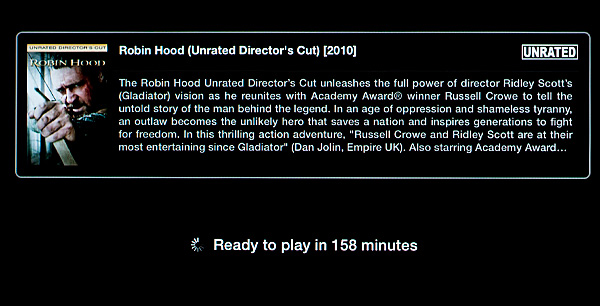The Apple TV (2010) Review
by Anand Lal Shimpi on October 4, 2010 12:07 AM ESTApple TV Movie Rental
The Apple TV isn’t just for streaming content you have stored in iTunes, you can also rent TV shows and movies directly on the device. The pricing structure is similar to other á la carte streaming services online:
| Apple TV Rental Pricing | |||||
| Content | Price | Days to Start | Time to Watch Once Started | ||
| TV Show | $0.99 | 30 | 48 hours | ||
| Movie | $3.99 - $4.99 | 30 | 24 hours | ||
To rent a new movie release it’s a one time fee of either $3.99 or $4.99. You have 30 days to start the movie and 24 hours to watch it once you’ve started. That’s expensive compared to Red Box or, well piracy, but the idea is that you get new releases and you get them legally.
There’s no ability to purchase movies on the Apple TV, you’ll need to do that on your Mac/PC and stream it over to the ATV. This box is rental-only.

The fee structure works but if you rent a lot you’ll quickly rack up more charges than you would with a service like Netflix or Blockbuster. The former is good for older titles, while the latter can get you the same things the iTunes store can - you just have to wait for a DVD to come in the mail. As far as an instant service goes, Apple is relatively competitive. The pricing and movie availability is comparable although I did notice that Iron Man 2 was available to rent via Amazon’s Video on Demand service, but not on the Apple TV. Other new releases like Get Him to the Greek were on all competing streaming platforms.

The image quality of the rentals is determined mostly by bitrate. Thankfully with H.264 you can get pretty decent quality out of low bitrate video. I rented Robin Hood in HD and based on the rate of streaming and the estimated time to completion I calculated the total file size for the 155 minute film at somewhere between 4 - 5GB. If we do the math that works out to be 3.5 - 4.4Mbps. That’s significantly higher than a standard definition rental through Amazon’s Video on Demand or even through iTunes (1.3Mbps and 1.5Mbps respectively). As a result, the Apple TV movie rentals actually look reasonably good. I picked out some macroblocking so it’s not going to be perfect. Note that Blu-ray discs can offer an order of magnitude higher bitrate so the Apple TV may be good, but it’s no Blu-ray replacement. Even most illegal content you can find online is encoded to higher specs.

Preparing to stream, the actual process took far less than 158 minutes
You can start watching your movie once the Apple TV has downloaded at least 5% of it based on my experience. That translates to around 256MB in the worst case scenario, not too bad assuming your internet and Apple’s servers are both behaving properly.
The Apple TV store is technically separate from anything you do on your Mac/PC. If you rent something in iTunes on your Mac/PC it doesn’t appear as rented on your Apple TV. There’s no concept of moving your movies to the Apple TV, despite the device having 8GB of storage. The NAND is strictly used as a cache for movies you rent on the Apple TV. Instead you have to stream any iTunes rented content over or rent again on the Apple TV.










36 Comments
View All Comments
Anand Lal Shimpi - Monday, October 4, 2010 - link
Thanks for the correction, fixed :)cjs150 - Monday, October 4, 2010 - link
And it will look like the Apple TV.What a simple concept, small box, very limited backplate. Lets think about it how about a box that had the following connectors
1. Ethernet connection (but a bit faster)
2. HDMI connection
3. Audio out (personally would not bother and take through HDMI)
4. USB
5. Wifi (optional for me because house if wired)
Add in 2 Gb of memory a small SSD for OS + limited applications
Plays movies, TV, music. Can surf web and basically that is it.
Would need some sort of wireless connection to allow remote control and to attach a keyboard (if only to type web addresses).
Apple have got the size of the box about right. Even a mini-itx board has too many features that would not be needed for the ideal straming box.
Apple has given me a glimpse of the future - it looks like Apple TV but it will be something else
tipoo - Monday, October 4, 2010 - link
Is that a typo, or can it really go that high? Apple's official specs list MPEG-4 video, up to 2.5 Mbps and Motion JPEG (M-JPEG) up to 35 Mbps.Docchris - Monday, October 4, 2010 - link
he was specifically testing non-apple videos to ty and break it, so what apples specs state doesn't really matter.i was just curious where he got a video form which exceeds the blu-ray specification
Anand Lal Shimpi - Monday, October 4, 2010 - link
http://www.networkedmediatank.com/showthread.php?t...I remuxed the files as .mov without re-encoding and sent them over to the Apple TV. Even if I re-encoded down to 10Mbps there was still some slight stuttering so there's something unusually stressful about these samples. At 70Mbps or above the Apple TV would start behaving very strange, the video player app would either crash or the unit would reboot before finishing playback.
Take care,
Anand
tech6 - Monday, October 4, 2010 - link
While the cable and content oligopoly are terrified of IP based home entertainment, no legitimate solution will truly replace cable. Cable is simply too good of a revenue stream not to protect by these companies. Once they have "cabel-ized" the Internet through the defeat of net neutrality and can restrict and monitor users Internet activities then I'm sure we will see a lot more IP TV but at the expense of any freedom or anonymity that we may have ever had on the Internet.mfenn - Monday, October 4, 2010 - link
Perfect response! XDvol7ron - Monday, October 4, 2010 - link
"You can argue that it’s for firmware updates but there’s also WiFi/Ethernet for that."Isn't WiFi firmware update for anything considered bad practice? Or have people turned the other cheek on this?
Anand Lal Shimpi - Monday, October 4, 2010 - link
Technically as long as the firmware package can download over WiFi and execute once completely downloaded it should be ok. I agree USB seems like the safer bet though, particularly if there's a firmware update that fixes a network issue.Take care,
Anand
naho - Monday, October 4, 2010 - link
"Unlike a smartphone it eats a good amount of power at idle - a whole 1.8W. I don’t think Apple even bothered to enable serious power management on the A4 in the Apple TV, it’s just not necessary."What would power management reducing idle power to 0.8 W have saved customers?
Eg. if 5 million units are sold of this model x 22 hours idle per day x average product lifetime 4 years x 365 days/year x 0.12$/kWh (maybe less in US, more Europe) = 160.6 GWh x 0.12$/kWh = 19.27 million dollars in additional electricity bills.